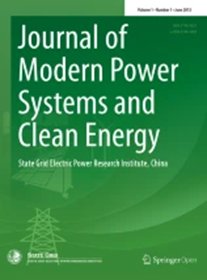Learning-Aided Collaborative Optimization of Power, Hydrogen, and Transportation Networks
IF 6.1
1区 工程技术
Q1 ENGINEERING, ELECTRICAL & ELECTRONIC
Journal of Modern Power Systems and Clean Energy
Pub Date : 2024-11-27
DOI:10.35833/MPCE.2024.000563
引用次数: 0
Abstract
The gradual replacement of gasoline vehicles with electric vehicles (EVs) and hydrogen fuel cell vehicles (HFCVs) in recent years has provided a growing incentive for the collaborative optimization of power distribution network (PDN), urban transportation network (UTN), and hydrogen distribution network (HDN). However, an appropriate collaborative optimization framework that addresses the prevalent privacy concerns has yet to be developed, and a sufficient pool of system operators that can competently operate all three networks has yet to be obtained. This study proposes a differentiated taxation-subsidy mechanism for UTNs, utilizing congestion tolls and subsidies to guide the independent traffic flow of EVs and HFCVs. An integrated optimization model for this power-hydrogen-transportation network is established by treating these vehicles and the electrolysis equipment as coupling bridges. We then develop a learning-aided decoupling approach to determine the values of the coupling variables acting among the three networks to ensure the economic feasibility of collaborative optimization. This approach effectively decouples the network, allowing it to operate and be optimized independently. The results for a numerical simulation of a coupled system composed of a IEEE 33-node power network, 13-node Nguyen-Dupuis transportation network, and 20-node HDN demonstrate that the proposed learning-aided approach provides nearly equivalent dispatching results as those derived from direct solution of the physical models of the coupled system, while significantly improving the computational efficiency.电力、氢和交通网络的学习辅助协同优化
近年来,随着电动汽车(ev)和氢燃料电池汽车(HFCVs)的逐步取代汽油车,为配电网(PDN)、城市交通网络(UTN)和氢配网(HDN)的协同优化提供了越来越大的动力。然而,解决普遍存在的隐私问题的适当的协作优化框架尚未开发,并且尚未获得足够的系统操作员池,可以胜任操作所有三个网络。本研究提出了一种针对utn的差别化税收补贴机制,利用拥堵费和补贴来引导电动汽车和氢燃料汽车的独立交通流。将上述车辆与电解设备作为耦合桥梁,建立了动力-氢运输网络的集成优化模型。然后,我们开发了一种学习辅助解耦方法来确定在三个网络之间作用的耦合变量的值,以确保协同优化的经济可行性。这种方法有效地解耦了网络,使其能够独立运行和优化。对一个由IEEE 33节点电网、13节点Nguyen-Dupuis交通网络和20节点HDN组成的耦合系统进行了数值模拟,结果表明,所提出的学习辅助方法与直接求解耦合系统物理模型得到的调度结果几乎相当,同时显著提高了计算效率。
本文章由计算机程序翻译,如有差异,请以英文原文为准。
求助全文
约1分钟内获得全文
求助全文
来源期刊

Journal of Modern Power Systems and Clean Energy
ENGINEERING, ELECTRICAL & ELECTRONIC-
CiteScore
12.30
自引率
14.30%
发文量
97
审稿时长
13 weeks
期刊介绍:
Journal of Modern Power Systems and Clean Energy (MPCE), commencing from June, 2013, is a newly established, peer-reviewed and quarterly published journal in English. It is the first international power engineering journal originated in mainland China. MPCE publishes original papers, short letters and review articles in the field of modern power systems with focus on smart grid technology and renewable energy integration, etc.
 求助内容:
求助内容: 应助结果提醒方式:
应助结果提醒方式:


